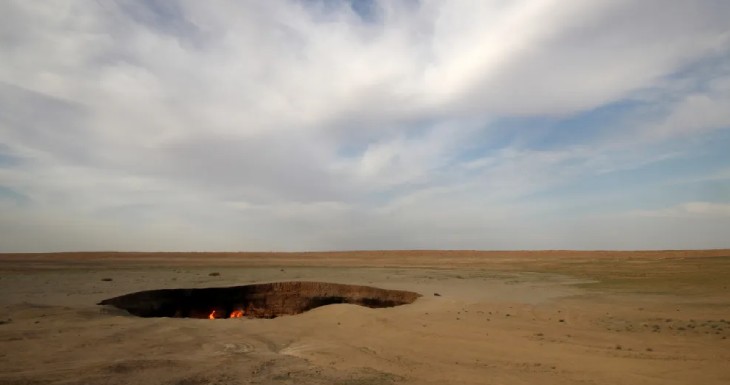In the heart of the Karakum Desert in Turkmenistan, there is a spectacle that seems straight out of a science fiction movie or an ancient legend: the Darvaza Shaft, also known as the Gates of Hell, a giant crater that has been burning relentlessly for more than 50 years.
How did this wonder (and warning) of modern nature come about? Why is it still burning?
It all began in 1971, when Soviet geologists were drilling for natural gas. What they found was an underground cavern filled with methane gas that collapsed, forming a huge crater. Concerned about a possible release of toxic gases, the scientists decided to set it on fire, thinking it would burn out in a few days.
But they miscalculated: The shaft held much more gas than expected. Since then, the gas has continued to flow unabated, keeping the fire burning.
The crater is about 70 meters in diameter and 30 meters deep, and at night, the glow of the flames turns the desert landscape into a surreal sight. This phenomenon has become an unexpected tourist attraction: travelers from all over the world come to this remote corner of the world just to see the fire bursting from the earth.
A feat as risky as it is fascinating: a record-breaking descent:
In 2013, Canadian explorer and filmmaker George Kourounis became the first person to climb inside the burning crater. After two years of planning, he had only 17 minutes to obtain gas readings and soil samples before being hoisted up again. The expedition was sponsored by National Geographic, and its images are as impressive as they are disturbing: a man wrapped in orange flames, suspended inside a living cauldron.

The most curious thing: will it ever go out?
The Turkmen government has considered shutting it down on several occasions to reduce its environmental impact and make better use of natural gas resources. In 2022, the president even called for ways to extinguish it to be studied. However, to this day, the "Gate of Hell" remains open. And as long as the subsoil continues to release methane gas, the flames will continue.
Today, Darvaza is more than just a burning pit: it is a postcard of nature’s power, a story of scientific mistakes, and a testament to how something uncontrollable turned into marketing, becoming the region’s main tourist attraction.
What if it goes out one day? Perhaps, it will become a different kind of attraction. But for now, the Gate of Hell welcomes thousands of travelers, who even choose to camp near the crater to enjoy the surreal view under a starry sky.


